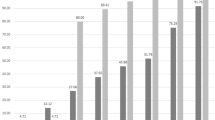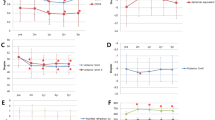Abstract
We report 1-year follow-up findings on 42 of the first epikeratophakia procedures performed for keratoconus at the Helsinki University Central Hospital. Altogether 40 patients (42 eyes) received epikeratophakia grafts to flatten their cones. The age of the patients ranged between 19 and 44 years. The mean follow-up for these patients was 10.7 ± 4.4 months, and in 12 patients follow-up extended to over 12 months. Overall, the success rate for the procedure was 93%, and with repeated surgery it was 97% for all patients; in all patients uncorrected visual acuity improved. Preoperatively 82% of the patients had uncorrected acuity worse than 20/400, while all patients followed for 1 year had uncorrected visual acuity better than 20/400. At 6 and 12 months postoperatively best corrected visual acuities were all returned to within one line of their preoperative best corrected acuity; in 83% acuities were 20/40 or better 12 months postoperatively. Four patients out of 12 followed for 1 year needed no postoperative overrefraction at all. The mean flattening by keratometry readings was 9.8 diopters (D) and the mean decrease in myopia in terms of spherical equivalent was 5.3 D. The degree of irregular astigmatism was measured in five cases using LSU topographical corneal shape analysis, and showed that the mean preoperative irregular astigmatism of 3.9 D was reduced to 1.3 D in the long-term analysis. One case report is presented to show in detail the topographical changes induced by epikeratophakia in keratoconus. The noninvasive nature of the epikeratophakia procedure makes it a safe and desirable option for the treatment of keratoconus.
Similar content being viewed by others
References
Dietze TR, Durrie DS (1988) Indications and treatment of keratoconus using epikeratophakia. Ophthalmology 95:236–244
Dingeldein SA, Pittman SD, Wang J, Klyce SD (1988) Analysis of corneal topographic data. Invest Ophthalmol Vis Sci [Suppl] 29:389
Kaufman HE (1980) The correction of aphakia. Am J Ophthalmol 89:1–10
Kaufman HE, Werblin TP (1982) Epikeratophakia for the treatment of keratoconus. Am J Ophthalmol 93:342–347
Keates RH, Falkenstein S (1972) Keratoplasty in keratoconus. Am J Ophthalmol 74:442–444
Klyce SD (1984) Computer-assisted corneal topography: high-resolution graphical presentation and analysis of keratoscopy. Invest Ophthalmol Vis Sci 25:1425–1435
Klyce SD, Dingeldein SA, Pittman SD, Wang J (1988) Computer-assisted analysis of topographic data in human corneas. Ophthalmology [Suppl] 95:163
Krachmer JH, Feder RS, Belin MW (1984) Keratoconus and related noninflammatory corneal thinning disorders. Surv Ophthalmol 28:293–322
Lass JH, Stocker EG, Fritz ME, Collie DM (1987) Epikeratoplasty: the surgical correction of aphakia, myopia and keratoconus. Ophthalmology 94:912–925
Lehtosalo J, Uusitalo RJ, Mianowicz J (1987) Epikeratophakia for treatment of keratoconus. Acta Ophthalmol [Suppl 182] 65:74–77
Maguire LJ, Singer DE, Klyce SD (1987) Graphic presentation of computer-analyzed keratoscope photographs. Arch Ophthalmol 105:223–230
McDonald MB, Koenig SB, Safir A, Kaufman HE (1983) Onlay lamellar keratoplasty for the treatment of keratoconus. Br J Ophthalmol 67:615–618
McDonald MB, Kaufman HE, Durrie DS, Keates RH, Sanders DR, and the other medical monitors of the nationwide study (1986) Epikeratophakia for keratoconus: the nationwide study. Arch Ophthalmol 104:1294–1300
Moore TE, Aronson SB (1978) Results of penetrating keratoplasty in keratoconus. Adv Ophthalmol 37:106–108
Morgan KS, Arffa RC, Marvelli TL, Verity SM (1986) Five-year follow-up of epikeratophakia in children. Ophthalmology 93:423–432
Steinert RF, Wagoner MD (1988) Long-term comparison of epikeratoplasty and penetrating keratoplasty for keratoconus. Arch Ophthalmol 106:493–496
Troutman RC, Gaster RN (1980) Surgical advances and results of keratoconus. Am J Ophthalmol 90:131–136
Uusitalo RJ, Lehtosalo J (1987) Epikeratophakia in aphakic children. Am J Ophthalmol 103:465–466
Uusitalo RJ, Lehtosalo J (1987) Epikeratophakia in children. Acta Ophthalmol [Suppl 182] 65:78–82
Uusitalo RJ, Lehtosalo J (1989) Visual, refractive and keratometric results of epikeratophakia in children. Arch Ophthalmol 107:358–363
Young SR, Olson RJ (1985) Results of a double running suture in penetrating keratoplasty performed on keratoconus patients. Ophthalmic Surg 16:779–786
Author information
Authors and Affiliations
Additional information
This research was supported in part by grants from the Juselius Foundation and by the Finnish Eye and Tissue Bank Foundation, Finland
Rights and permissions
About this article
Cite this article
Uusitalo, R.J., Lehtosalo, J. & Klyce, S.D. One-year follow-up of epikeratophakia for keratoconus. Graefe's Arch Clin Exp Ophthalmol 227, 401–407 (1989). https://doi.org/10.1007/BF02172888
Received:
Accepted:
Issue Date:
DOI: https://doi.org/10.1007/BF02172888




